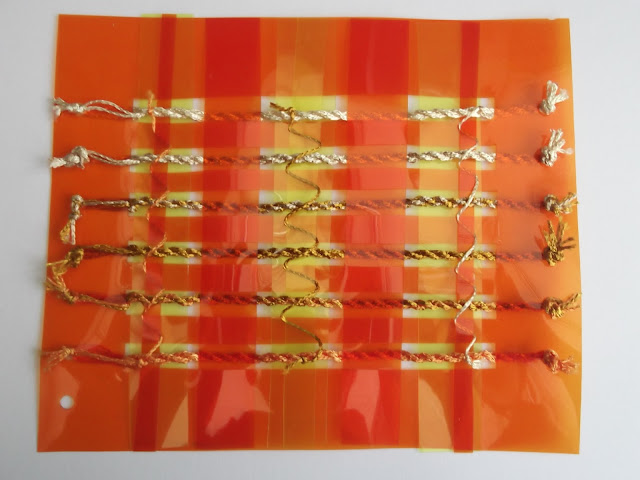I started off using conventional yarns like knitting wool and embroidery cottons, working with different thicknesses of yarn. This helped me to learn some different techniques for making braids etc.
It soon became clear that restricting myself to these materials would severely restrict the qualities I could expect to produce in the braid.
In particular I would find it difficult to get very shiny or hard qualities.
I tried adding a shiny ribbon.
This looked familiar as it is a decorative touch which is used frequently.
Then I tried a combination of strips of plastic bag and bubble wrap, which is shiny in a particularly wet kind of way.
This blurred photo is an attempt to show the combination of copper florist's wire and picture wire that I braided to make a shiny and hard braid.
I like the effect, and the surprising colourfulness of it. It is of course very strong and flexible and could be useful structurally.
This was my next attempt at making something hard. It is from strips cut from a 2 litre milk bottle.
It was more difficult to braid than the other materials tried so far, because it was not so flexible, and was already fixed in a shape. I didn't really have a choice about which kind of braid I did with it, because it didn't have the flexibility for the more rounded ones.
I am pleased with the stiffness and flatness of it - it looks a bit like a shed snake skin.
Most of the rest of my braids were experiments in softness of various qualities.
This was made from very thick wool of the kind that is sold to make into 'a scarf in an hour'. It is soft to the touch but when made up with this technique it looks like rope, which I think detracts from the softness quality.
This was made with the pale pink mohair/silk blend wool, and twisted strips of undyed packing paper.
It certainly has a softness in its appearance, although when you get closer and can see it's made of paper it has a rather neglected fragile look to it. I think the wool was wasted in this combination because its soft qualities don't show up against the paper at all.
This was made from the very soft cotton string that came with the tags I was using to label these braids.
The softness is surprising in such a utititarian product.
This braid is the softest yet - made from strips cut from old tights. The plumpness of the curves adds to the feeling of softness.
Finally, a braid made from strips of the white fake leather fabric. It looks solid but is in fact a tube surrounded completely by interwoven strips of the fabric. It looks lie a riding crop or something ornamental from a 19th century sodier's dress costume. I was surprised how neatly it turned out just from having a one-sided fabric and cutting the strips quite wide so I had to turn them very carefully each time.
Exercise 3: Hand-twisted ropes
The aim was to attach braids to a frame, paying particular attention to the way it worked with light.











No comments:
Post a Comment